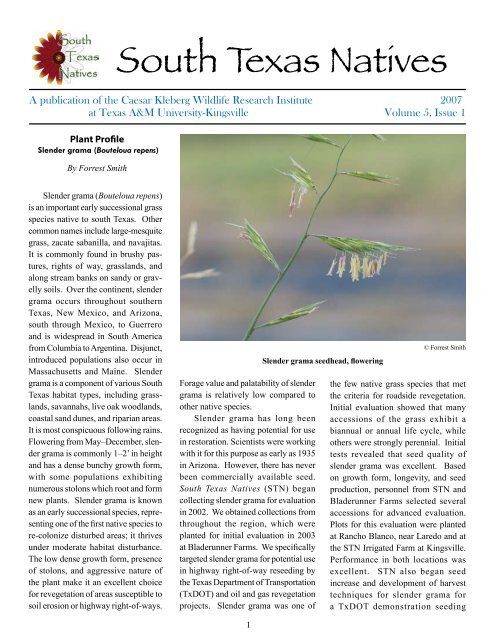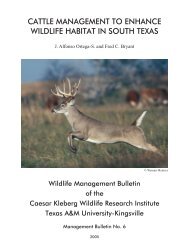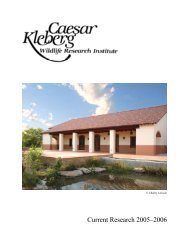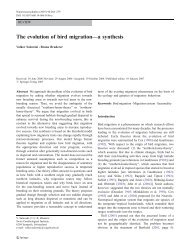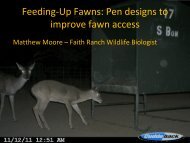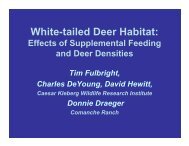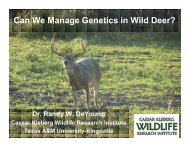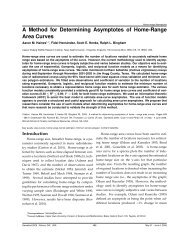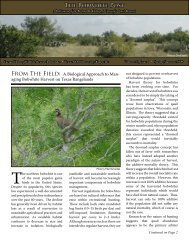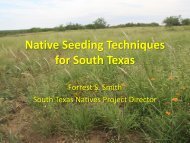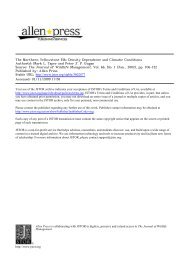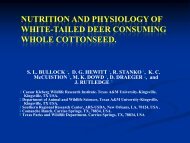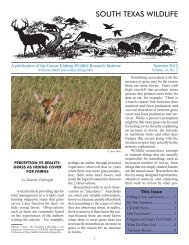South Texas Natives - Caesar Kleberg Wildlife Research Institute ...
South Texas Natives - Caesar Kleberg Wildlife Research Institute ...
South Texas Natives - Caesar Kleberg Wildlife Research Institute ...
Create successful ePaper yourself
Turn your PDF publications into a flip-book with our unique Google optimized e-Paper software.
<strong>South</strong> <strong>Texas</strong> <strong>Natives</strong><br />
A publication of the <strong>Caesar</strong> <strong>Kleberg</strong> <strong>Wildlife</strong> <strong>Research</strong> <strong>Institute</strong> 2007<br />
at <strong>Texas</strong> A&M University-Kingsville Volume 5, Issue 1<br />
Plant Profile<br />
Slender grama (Bouteloua repens)<br />
By Forrest Smith<br />
Slender grama (Bouteloua repens)<br />
is an important early successional grass<br />
species native to south <strong>Texas</strong>. Other<br />
common names include large-mesquite<br />
grass, zacate sabanilla, and navajitas.<br />
It is commonly found in brushy pastures,<br />
rights of way, grasslands, and<br />
along stream banks on sandy or gravelly<br />
soils. Over the continent, slender<br />
grama occurs throughout southern<br />
<strong>Texas</strong>, New Mexico, and Arizona,<br />
south through Mexico, to Guerrero<br />
and is widespread in <strong>South</strong> America<br />
from Columbia to Argentina. Disjunct,<br />
introduced populations also occur in<br />
Massachusetts and Maine. Slender<br />
grama is a component of various <strong>South</strong><br />
<strong>Texas</strong> habitat types, including grasslands,<br />
savannahs, live oak woodlands,<br />
coastal sand dunes, and riparian areas.<br />
It is most conspicuous following rains.<br />
Flowering from May–December, slender<br />
grama is commonly 1–2’ in height<br />
and has a dense bunchy growth form,<br />
with some populations exhibiting<br />
numerous stolons which root and form<br />
new plants. Slender grama is known<br />
as an early successional species, representing<br />
one of the first native species to<br />
re-colonize disturbed areas; it thrives<br />
under moderate habitat disturbance.<br />
The low dense growth form, presence<br />
of stolons, and aggressive nature of<br />
the plant make it an excellent choice<br />
for revegetation of areas susceptible to<br />
soil erosion or highway right-of-ways.<br />
Forage value and palatability of slender<br />
grama is relatively low compared to<br />
other native species.<br />
Slender grama has long been<br />
recognized as having potential for use<br />
in restoration. Scientists were working<br />
with it for this purpose as early as 1935<br />
in Arizona. However, there has never<br />
been commercially available seed.<br />
<strong>South</strong> <strong>Texas</strong> <strong>Natives</strong> (STN) began<br />
collecting slender grama for evaluation<br />
in 2002. We obtained collections from<br />
throughout the region, which were<br />
planted for initial evaluation in 2003<br />
at Bladerunner Farms. We specifically<br />
targeted slender grama for potential use<br />
in highway right-of-way reseeding by<br />
the <strong>Texas</strong> Department of Transportation<br />
(TxDOT) and oil and gas revegetation<br />
projects. Slender grama was one of<br />
Slender grama seedhead, flowering<br />
© Forrest Smith<br />
the few native grass species that met<br />
the criteria for roadside revegetation.<br />
Initial evaluation showed that many<br />
accessions of the grass exhibit a<br />
biannual or annual life cycle, while<br />
others were strongly perennial. Initial<br />
tests revealed that seed quality of<br />
slender grama was excellent. Based<br />
on growth form, longevity, and seed<br />
production, personnel from STN and<br />
Bladerunner Farms selected several<br />
accessions for advanced evaluation.<br />
Plots for this evaluation were planted<br />
at Rancho Blanco, near Laredo and at<br />
the STN Irrigated Farm at Kingsville.<br />
Performance in both locations was<br />
excellent. STN also began seed<br />
increase and development of harvest<br />
techniques for slender grama for<br />
a TxDOT demonstration seeding<br />
1
© Forrest Smith<br />
Keith Pawelek, Manager of Production & Commercialization, standing in a seed<br />
increase block of slender grama at Bladerunner Farms, Inc., at Poteet, TX<br />
project. We found that commercial<br />
production potential of this grass was<br />
high, as growth, maintenance, and<br />
production of seed were easier than<br />
many native species previously worked<br />
with. The outstanding accessions were<br />
increased from original seed at <strong>Texas</strong><br />
Agricultural Experiment Station in<br />
Beeville (TAES-B). Excellent growth<br />
and seed production, and encroachment<br />
into adjacent areas was noted by<br />
personnel there.<br />
In 2006, in cooperation with<br />
TAES-B and the E. Kika De La Garza<br />
Plant Materials Center, the 4 accessions<br />
selected for advance evaluation and<br />
seed increase at Beeville were released<br />
as a blend named “Dilley” germplasm<br />
slender grama. Further seed increase<br />
was initiated in conjunction with Bladerunner<br />
Farms, where 0.25 acre increase<br />
plots were established of each accession.<br />
The first breeder seed of Dilley<br />
was made available to commercial<br />
producers in the fall of 2006 under a<br />
memorandum of agreement with STN.<br />
Bladerunner Farms has planted the first<br />
commercial production field of the<br />
release, and to date has seen excellent<br />
performance of the release. The first<br />
harvest is expected in the fall of 2007.<br />
Additional evaluation and seeding<br />
trial experiments involving Dilley are<br />
being conducted by STN. A project at<br />
the Welder <strong>Wildlife</strong> Refuge is attempting<br />
to determine the herbicide tolerance<br />
and competitive ability of slender<br />
grama in areas infested with old world<br />
bluestems. Severe drought conditions<br />
persisted for 8 months following this<br />
seeding; however slender grama was<br />
noted as having the best emergence<br />
among the 10 native species planted<br />
when rains finally came in late summer<br />
2005. Slender grama plots continue to<br />
thrive despite re-infestation of the area<br />
by old world bluestems. Additional<br />
field trials were established in June of<br />
2007 at the Welder Refuge. Seeding<br />
rates and season of seeding are being<br />
evaluated at Rancho Blanco to determine<br />
the best methods for establishment.<br />
Data collected so far has shown<br />
that greatest stand establishment occurs<br />
when Dilley is seeded in late summer.<br />
Results from this research will also<br />
help to determine proper seeding rates<br />
for right-of-way plantings This plant-<br />
ing has also shown slender grama to<br />
have good competitive ability against<br />
buffelgrass (Pennisetum ciliare). Our<br />
previous evaluations have also shown<br />
it to be competitive with common bermudagrass<br />
(Cynodon dactylon).<br />
We are also documenting the insect<br />
use of slender grama. Several insect<br />
species have been noted that can be<br />
detrimental to commercial seed production,<br />
including thrips and rice stink<br />
bugs. Proper control methods are being<br />
refined to address these pests. On an<br />
interesting side note, we have observed<br />
large numbers of honeybees lighting<br />
and gathering pollen on seedheads in<br />
mid-summer. Previous research has<br />
pointed to slender grama being windpollinated.<br />
However, the grass may<br />
also be insect pollinated, and provide<br />
much needed food sources to bees and<br />
other pollinators in times when other<br />
food sources may be in short supply.<br />
For pure stands, Dilley germplasm<br />
slender grama should be seeded at a rate<br />
of 8 lbs. pure live seed per acre. When<br />
planted in a mixture of native species,<br />
seeding rates should be adjusted accordingly.<br />
Slender grama rarely occurs in<br />
pure stands under native conditions.<br />
Seed can be coated for planting so that<br />
it will flow more easily through seed<br />
drills. Greatest success establishing<br />
slender grama has been by broadcast<br />
seeding and lightly covering the seed<br />
with a roller packer, or from drilling<br />
coated seed into moist soil. Planting<br />
depth should be ¼” or less.<br />
We recommend planting slender<br />
grama as part of a mix of native species<br />
in rangeland plantings. However,<br />
this grass has many non-traditional<br />
uses not often associated with native<br />
species. Its low palatability, easy and<br />
quick establishment, and preference<br />
for disturbed conditions make it an<br />
excellent tool for erosion control<br />
in areas denuded by livestock, oil<br />
and gas exploration, or construction.<br />
Seeding Dilley slender grama following<br />
2
disturbances may help impede invasion<br />
by non-native species, control soil<br />
erosion, and prepare the soil for later<br />
establishment of other more desirable<br />
native species. The greatest potential<br />
use of Dilley is for highway rightof-way<br />
reseeding. The low growth<br />
form of the grass should help reduce<br />
mowing costs, and quick establishment<br />
characteristics adequately meet TxDOT<br />
requirements. Frequent mowing of<br />
slender grama does not seem to affect<br />
its longevity. Dilley may also have use<br />
in residential and urban settings for<br />
high-traffic areas and as an attractive,<br />
extremely drought tolerant ornamental<br />
native grass.<br />
Foundation seed of Dilley is currently<br />
available to commercial seed<br />
producers. Seed for public purchase<br />
will be available spring 2008. We<br />
believe that Dilley will be extremely<br />
useful to a variety of consumers, and<br />
feel that its use in place of exotic species<br />
will be an excellent testimony to<br />
the importance and further development<br />
of more valuable native plant<br />
resources.<br />
Forrest Smith is the Manager of Native Plant<br />
Collections and Evaluations for STN.<br />
Munda, B.D. and M.J. Pater. 2003 Revegetation<br />
practices on the Santa Rita<br />
Experimental Range. USDA Forest<br />
Service Proceedings RMRS-P-30.<br />
United States Department of Agriculture.<br />
2007. PLANTS Database. http://<br />
plants.usda.gov/.<br />
The Progress of Native Plant<br />
Restoration in Buffelgrass<br />
By Aaron Tjelmeland<br />
In the last 50 years, exotic grasses<br />
have become as much a part of the<br />
south <strong>Texas</strong> landscape as prickly pear<br />
cactus and mesquite. The impact of<br />
these grasses on native plants and wildlife<br />
has been significant and varies by<br />
species. Some species remain more<br />
or less where they’re planted, while<br />
others readily invade areas where they<br />
were not planted and are referred to<br />
as “invasive exotics”. Our research<br />
focuses on buffelgrass, an African<br />
grass brought to south <strong>Texas</strong> in the<br />
1940s.<br />
Since the introduction of buffelgrass,<br />
an estimated 9.8 million acres<br />
of south <strong>Texas</strong> has been converted<br />
to this exotic grass. The colonization<br />
of buffelgrass is aided by soil<br />
disturbance, such as disking or root<br />
plowing, near seed sources. Buffelgrass<br />
appears to invade aggressively<br />
in certain environments, but not in<br />
others. Once established, buffelgrass<br />
is frequently able to out-compete<br />
native plants, especially on heavy clay<br />
loam soils. It can also support a fire<br />
cycle that favors its propagation and<br />
survival. Furthermore, a study completed<br />
in 2002 found that a mixture of<br />
exotic grasses, including buffelgrass,<br />
reduced the abundance of bobwhite<br />
quail and other grassland birds, as<br />
well as insects, which are important<br />
quail food items.<br />
We initiated a series of studies<br />
focused on restoration and diversification<br />
of areas dominated by buffelgrass.<br />
The first of these studies was initiated<br />
in 2002, which utilized several herbicides<br />
in an attempt to establish several<br />
native grass species within a buffelgrass<br />
pasture. Although all areas eventually<br />
returned to buffelgrass within<br />
2 years, results of this early research<br />
References<br />
Correll, D.V., and M.S. Johnston. 1996.<br />
Manual of the Vascular Plants of <strong>Texas</strong>.<br />
The University of <strong>Texas</strong> at Dallas.<br />
Dallas, <strong>Texas</strong>. Fourth Printing.<br />
Everitt, J.H., C.L. Gonzalez, G. Scott, and<br />
B.I. Dahl. 1981. Seasonal food preferences<br />
of cattle on native range in the<br />
<strong>South</strong> <strong>Texas</strong> Plains. J. Range Management.<br />
34:384–388.<br />
Gonzalez C.L. and J.H. Everitt. 1982. Nutrient<br />
contents of major food plants eaten<br />
by cattle in the <strong>South</strong> <strong>Texas</strong> Plains. J.<br />
Range Management. 35(6):733–736.<br />
Gould, F.W. 1975. The Grasses of <strong>Texas</strong>.<br />
<strong>Texas</strong> A&M University Press. College<br />
Station, <strong>Texas</strong>.<br />
Lonard, R.I. 1993. Guide to the Grasses of<br />
the Lower Rio Grande Valley, <strong>Texas</strong>.<br />
The University of <strong>Texas</strong>-Pan American<br />
Press, Edinburg <strong>Texas</strong>.<br />
Aaron Tjelmeland inspecting Buffelgrass<br />
© Timothy Fulbright<br />
3
STN Welcomes New<br />
Office Coordinator<br />
By Robin Harkey<br />
Shortspike windmillgrass seeded into buffelgrass<br />
taught us that the potential may exist<br />
for native grasses of the genus Chloris,<br />
which seem to have an increased<br />
tolerance to some herbicides.<br />
As we finished collection and analysis<br />
of the 2002 experiment, we began<br />
a similar experiment in 2004 using<br />
the herbicide Arsenal® along with a<br />
mixture of native grasses. The native<br />
grass shortspike windmillgrass, of the<br />
genus Chloris, exhibited a resistance<br />
to Arsenal® and a high resistance to<br />
drought conditions, which have been<br />
prevalent since late 2004. The E. Kika<br />
de la Garza USDA-NRCS Plant Materials<br />
Center (PMC) and <strong>South</strong> <strong>Texas</strong><br />
<strong>Natives</strong> is conducting further experiments<br />
with shortspike as well as other<br />
Chloris species to select accessions<br />
that are better adapted to the climatic<br />
conditions of south <strong>Texas</strong>.<br />
While we’ve been experimenting<br />
with native grasses, we’ve also begun<br />
to experiment with legumes as well. In<br />
2004, we attempted to establish a seed<br />
mix called BeeWild Bundleflower®,<br />
which is a mixture of bundleflower<br />
cultivars from Mexico. This mixture<br />
did not establish well due mainly to<br />
the severe drought conditions that we<br />
© Aaron Tjelmeland<br />
experienced; although, deer browsing<br />
also played a minor role. While this<br />
seed mix is not native to south <strong>Texas</strong>,<br />
the methods of establishment could be<br />
used for native legumes. Currently,<br />
the PMC has developed a sufficient<br />
seed stock of prairie acacia and future<br />
experiments have been planned using<br />
this native legume.<br />
Exotic grasses were introduced<br />
for forage and continue to be vital to<br />
cattle operations on a large portion of<br />
south <strong>Texas</strong> ranches. It is not likely<br />
that these grasses will go away anytime<br />
soon; however, we are dedicated<br />
to giving ranchers and land managers<br />
restoration options and tools for<br />
diversification whose interests are in<br />
wildlife and native plants. We foresee<br />
more efficient and cost-effective<br />
options for restoring areas dominated<br />
by buffelgrass as our understanding of<br />
these processes increase.<br />
Aaron Tjelmeland is currently working with<br />
Dr. Bart Ballard as the Program Coordinator<br />
for Migratory Bird <strong>Research</strong> at CKWRI.<br />
He received his master’s degree in Range<br />
& <strong>Wildlife</strong> from TAMUK, and received his<br />
bachelor’s degree in Animal Ecology and<br />
Botany from Iowa State University.<br />
<strong>South</strong> <strong>Texas</strong> <strong>Natives</strong> recently hired<br />
a new office coordinator in December<br />
of 2006. Annette Peterson is a welcome<br />
addition providing needed expertise<br />
in financial and overall administrative<br />
management. She focuses on the<br />
organization and tracking of grants<br />
and private accounts. She oversees the<br />
general maintenance within the office<br />
along with other duties such as website<br />
updates, newsletters and editing.<br />
Annette received a bachelor’s<br />
degree from Kansas State University<br />
in Horticulture and has worked in<br />
the sales and marketing industry for<br />
over 15 years. Most recently she has<br />
worked for the Epiphany Episcopal<br />
School in Kingsville as an administrative<br />
assistant with an emphasis on<br />
finance.<br />
Annette is married to Pete Peterson,<br />
head men’s basketball coach at<br />
<strong>Texas</strong> A&M-Kingsville. Annette and<br />
Pete have two daughters Hannah,<br />
age 15 and Leah, age 9. We gladly<br />
welcome Annette to the <strong>South</strong> <strong>Texas</strong><br />
<strong>Natives</strong> family!<br />
Robin Harkey is a former research associate<br />
with STN.<br />
© Forrest Smith<br />
<strong>South</strong> <strong>Texas</strong> <strong>Natives</strong> Office<br />
Coordinator, Annette Peterson.<br />
4
In Memory of<br />
Dr. Richard Hoverson<br />
By Paula Maywald & Forrest Smith<br />
On July 31, 2006 south <strong>Texas</strong><br />
lost a diligent steward of its natural<br />
resources, Dr. Richard R. Hoverson.<br />
The La Feria resident passed away<br />
at the age of 80. Richard’s contributions<br />
to plant and forage research,<br />
ranching, and the native plant industry<br />
were numerous. He wore many<br />
hats throughout his life, all helping to<br />
exhibit the resourcefulness and dedication<br />
of this self-proclaimed workaholic.<br />
Among these were U.S. Navy<br />
Service, agronomy specialist, forage<br />
specialist, private ranch consultant,<br />
seed producer, entomologist, boat<br />
rigger, fishing guide, native plant nurseryman,<br />
and most importantly, mentor<br />
to ranchers, students, and professionals.<br />
Richard served on the <strong>South</strong><br />
<strong>Texas</strong> <strong>Natives</strong> (STN) Technical Committee,<br />
making many valuable contributions<br />
to the direction and goals of<br />
the project.<br />
We first met Richard in 2002 at his<br />
native plant nursery in La Feria. Richard<br />
took a sincere interest in STN,<br />
as he had long ago seen the value of<br />
native plants. Richard donated many<br />
of the native plants that are today<br />
growing in the Range Garden between<br />
the <strong>Kleberg</strong> Ag Building and the Howe<br />
Ag Lab. Richard’s broad knowledge<br />
of the south <strong>Texas</strong> flora was inspiring<br />
to native plant enthusiasts, range and<br />
wildlife professionals, and land managers.<br />
He not only knew what each<br />
plant was, but more importantly, he<br />
knew the why, how, and what about<br />
each plant that you can’t learn in a<br />
classroom. His many years of being<br />
a student of the brush had taught him<br />
things about native plants that the<br />
average person has no way of comprehending.<br />
His nursery was a living<br />
herbarium of the flora of south <strong>Texas</strong>.<br />
Richard’s knowledge and enthusiasm<br />
of native plants was contagious.<br />
His work with ranchers also had a<br />
lasting impact on the region. He not<br />
only worked for landowners, but more<br />
importantly taught them. Throughout<br />
our travels and work with native<br />
plants, Richard’s name came up often,<br />
and always with highest regard and<br />
respect for his knowledge of native<br />
plants, and for the person he was.<br />
Richard started work with the<br />
<strong>Texas</strong> A&M Extension Service in<br />
1968. He served as an agronomy specialist,<br />
eventually becoming a forage<br />
specialist. While working with the<br />
extension service, he began consulting<br />
with ranchers in <strong>Texas</strong> and Mexico.<br />
This work led him to experimentation<br />
with various grasses for forage<br />
Dr. Richard Hoverson<br />
5<br />
© Daniel Hoverson<br />
production. Richard was a pioneer<br />
in working with ranches to realize<br />
the production potential of wildlife to<br />
their operations. Eventually, Richard<br />
began work developing seed production<br />
and harvest techniques for buffelgrass,<br />
his success eventually leading<br />
him into private enterprise as a fulltime<br />
seed salesman and private consultant.<br />
Eventually, the economy of<br />
Mexico, and a decline in buffelgrass<br />
sales forced Richard out of the consulting<br />
business. He tried becoming<br />
a fishing guide, but an untimely winter<br />
freeze crippled that industry as well.<br />
He then started <strong>Texas</strong> <strong>Natives</strong> Nursery<br />
and for the next 16 years was one of<br />
the largest producers of native plant<br />
material in the Rio Grande Valley.<br />
He produced close to 750,000 plants<br />
during his nursery career, while still<br />
handling fishing charters.<br />
Richard is survived by his wife of<br />
55 years, Ruby, 5 children: Michael,<br />
Daniel, John, Susan, and Jeanne; 8<br />
grandchildren, and one great-grandchild.<br />
His legacy and contribution to<br />
the natural resources of south <strong>Texas</strong><br />
lives on through many students, professionals,<br />
ranchers, and friends<br />
whom he influenced in his life and<br />
career. Perhaps most enduring though<br />
are the productive ranches, beautiful<br />
native landscapes, fields of grasses,<br />
and improved wildlife habitat Richard<br />
so directly played a role in; that is a<br />
wonderful legacy to be remembered<br />
by.<br />
Paula Maywald is the Coordinator for STN.<br />
Insects and Native Plants<br />
By Stephanie Campbell<br />
Insects are a valuable resource<br />
providing vital ecological services<br />
such as pollination, pest control,<br />
decomposition, and sustenance to<br />
wildlife species. In fact, the economic<br />
value of these services provided by wild<br />
native insects in the United States has<br />
been estimated to be at least $57 billion<br />
annually! Gallinaceous and migratory<br />
birds, as well as insectivorous fish, rely<br />
on insects for food. Without healthy<br />
populations of insects in suitable<br />
habitat, our wildlife would be in great<br />
peril, and the recreational wildlife<br />
activities Americans enjoy, such as
hunting, fishing, and bird watching,<br />
would be impacted.<br />
Native plants provide critical habitat<br />
that supports insects and wildlife.<br />
<strong>Research</strong>ers from the <strong>Caesar</strong> <strong>Kleberg</strong><br />
<strong>Wildlife</strong> <strong>Research</strong> <strong>Institute</strong> (CKWRI)<br />
have determined native bird abundance,<br />
diversity of bird species, and abundance<br />
of insects relative to native grass<br />
and exotic grass sites in south <strong>Texas</strong>.<br />
They observed that lark sparrows,<br />
black-throated sparrows, northern<br />
mockingbirds, northern bobwhite, and<br />
Cassin’s sparrow were more abundant<br />
on native grass sites than on non-native<br />
grass sites. Ground-foraging birds were<br />
found to be greater on native grass sites;<br />
similarly, these native grass sites were<br />
also found to have greater arthropod<br />
abundance (arthropods include insects,<br />
spiders, and crustaceans). Additionally,<br />
current research at the CKWRI conducted<br />
by Graduate <strong>Research</strong> Assistant<br />
Joey Sands indicates that the density<br />
of arthropods is greater in nativedominated<br />
grass sites, and arthropod<br />
abundance is less in areas dominated<br />
by buffelgrass rather than native plants.<br />
The diet of northern bobwhite chicks,<br />
especially in the first several weeks of<br />
life, includes protein-packed insects,<br />
such as grasshoppers, beetles, bugs,<br />
crickets, ants, termites, and spiders.<br />
Likewise, beetles, grasshoppers, flies,<br />
and leafhoppers comprise a major<br />
component in the diet of turkey poults.<br />
Clearly, the habitat native plants provide,<br />
along with the insects associated<br />
with these forbs and grasses, benefit our<br />
native wildlife.<br />
In <strong>South</strong> <strong>Texas</strong> <strong>Natives</strong>’ (STN)<br />
evaluation plots and seed increase<br />
fields, we have observed several insects<br />
that are known to benefit native plants<br />
by helping to prevent outbreaks of<br />
harmful pests. Many beetles, flies,<br />
and caterpillars help our native plants<br />
by serving as pollinators, soil builders,<br />
and predators of plant-eating insects.<br />
For example, the larval and adult<br />
ground beetles, predators belonging<br />
to the family Carabidae, will feed on<br />
damaging ground-inhabiting larvae,<br />
insect eggs, snails, and slugs. The<br />
larvae of the green lacewings (family<br />
Chrysopidae) feed on aphids and many<br />
other insects in larval and adult stages<br />
that can damage native plants. The<br />
Bordered Patch larvae on Awnless Bush Sunflower<br />
© Forrest Smith<br />
well-known ladybugs or ladybeetles<br />
(family Coccinellidae) are successful<br />
predators as larvae and adults as<br />
well. Their favorite snacks are aphids,<br />
but many species also feed on scales,<br />
thrips, mealybugs, mites and other<br />
harmful soft-bodied insects. We also<br />
collected the assassin bug, belonging to<br />
the Reduviidae family. In the nymph<br />
and adult stages, the assassin bug will<br />
feed on a variety of damaging insects<br />
such as flies, leafhoppers, caterpillars,<br />
and beetles in both the larval and adult<br />
stages. Beneficial spiders are always<br />
in great abundance. The numerous<br />
species, both immature and adult, are<br />
predators of a wide variety of insects,<br />
including flying insects and caterpillars.<br />
Damage by insects has also been<br />
observed in several forms. Physical<br />
damage to native plants is made by<br />
pests that feed on stems, leaves, flowers,<br />
fruit, and seed. Species known as<br />
stem borers actually tunnel a hole into<br />
the stem, interfering with the transfer of<br />
essential nutrients to the roots, stems,<br />
and leaves. The damage caused by<br />
pests can also lead to a plant’s increased<br />
susceptibility to disease by providing<br />
points of entry for pathogens, including<br />
fungi (causing molds and mildews),<br />
bacteria, and viruses. The physical<br />
damage caused by insects also leads to<br />
costs incurred in chemical pest management<br />
efforts, including the monetary<br />
cost of control, lost field work time<br />
to ensure protection from chemical<br />
exposure, and reduction in populations<br />
of beneficial insects.<br />
One of the primary advantages of<br />
commercially-produced native seed<br />
over wild harvested seed is the increased<br />
viability of the seed. Seed harvested in<br />
the wild often has very poor viability<br />
as a result of insect damage. When<br />
producing seed for restoration purposes<br />
and for distribution to commercial seed<br />
growers, chemical control of insects is<br />
often necessary to produce high-quality<br />
6
<strong>South</strong> <strong>Texas</strong> <strong>Natives</strong> Definitions:<br />
Revegetation - replanting plants for ecological, farm management or aesthetic purposes. Revegetation can increase<br />
the area of suitable habitat in the landscape, improve the quality of existing habitat, and help to link remnant or<br />
isolated habitats by providing ‘stepping stones’ and corridors.<br />
Restoration - the state of being restored to its former good condition, or the act of restoring something to a satisfactory<br />
state.<br />
Successional stage - A stage or recognizable condition of a plant community that occurs during its development<br />
from the bare ground to climax habitat. Recent theory points toward state and transitional models dealing with<br />
aggregations of co-specific plants whose abundance or occurrence is dictated by natural and man-induced disturbances.<br />
Invader - a species that has been introduced into an area beyond its native range. Invasions can result in losses of<br />
native species, changes in community structure and function, and alterations of the physical structure of the system.<br />
seed. Because chemical control of<br />
harmful insects also destroys populations<br />
of beneficial insects, care should<br />
be taken to ensure that harmful insect<br />
populations have reached a threshold<br />
where seed yield and quality or plant<br />
survival is negatively impacted before<br />
implementing chemical control. Severe<br />
infestations of harmful insects are often<br />
good indicators of other agronomic<br />
issues, such as poor plant health or<br />
vigor, low soil fertility, poor adaptation<br />
to the planting site, or environmental<br />
stresses, such as drought. Other times<br />
these harmful insect “booms” are a<br />
result of the large-scale production of<br />
native plant species that are typically<br />
less abundant or more widely distributed<br />
across the landscape in their native<br />
habitats. Irrigation of native plant<br />
stands for seed production in times of<br />
drought also influences harmful insect<br />
abundance. These irrigated stands<br />
often become the only food source for<br />
seed and plant eating insects, resulting<br />
in abnormal insect concentrations that<br />
must be controlled.<br />
In 2006, STN was faced with<br />
infestations of several insects. Thrips,<br />
tiny insects belonging to the order Thysanoptera,<br />
caused damage to sideoats<br />
grama (Bouteloua curtipendula), <strong>Texas</strong><br />
grama (B. rigidiseta), hairy grama (B.<br />
hirsuta var. hirsuta) and slender grama<br />
(B. repens). Plant-feeding thrips pierce<br />
a hole and suck out the contents of<br />
individual cells of leaves, flowers, and<br />
pollen causing a reduction in pollination<br />
and reduced seed fill (accumulation<br />
of food reserves). This, in turn,<br />
results in reduced seed production and<br />
reduced seed quality. The rice stink bug<br />
(Oebalus pugnax) infested our Arizona<br />
cottontop (Digitaria californica) and<br />
little bluestem (Schizachyrium scoparium)<br />
seed increase fields and our<br />
brownseed paspalum (Paspalum plicatulum)<br />
and pink pappusgrass (Pappophorum<br />
bicolor) evaluation plots.<br />
Rice stink bugs on Arizona cottontop<br />
The rice stink bug feeds on seeds with<br />
a piercing-sucking mouthpart called a<br />
proboscis. Nymphal and adult feeding<br />
removes the contents (the endosperm)<br />
from developing seeds during the milk<br />
and soft dough stages. We have also<br />
controlled fall armyworms (Spoloptera<br />
frugiperda) in Arizona cottontop and<br />
sideoats grama. These caterpillars<br />
occurred in large numbers following<br />
large rainfall events and at times when<br />
drought eliminated their other food<br />
sources. Armyworms will feed day<br />
and night on all above-ground plant<br />
© Forrest Smith<br />
7
parts and often cause severe damage<br />
to native grasses.<br />
When we sampled our seed<br />
increase fields, several other pests<br />
were observed and collected. However,<br />
these pest populations were not causing<br />
significant damage to warrant chemical<br />
control. For example, seed bugs,<br />
belonging to the family Lygaeidae,<br />
feed on mature seed, typically injecting<br />
saliva and sucking out the dissolved<br />
contents of the seed. We observed leaffooted<br />
or coreid bugs (family Coreidae)<br />
eating seed and foliage. Another pest<br />
we collected was the shield-backed<br />
bug (subfamily Scutelleridae), a plant<br />
feeder.<br />
Clearly, the promotion of native<br />
plants by STN is beneficial to wildlife<br />
and the insects wildlife utilize.<br />
The continued observation of insect<br />
populations in our evaluation plots will<br />
help us determine the beneficial and<br />
harmful insects that have the potential<br />
to establish populations in our future<br />
seed increase fields. In growing native<br />
plants, we strive to balance our efforts,<br />
protecting the beneficial insect species,<br />
managing the harmful populations, and<br />
producing quality seed.<br />
Stephanie Campbell is a former research<br />
associate with STN.<br />
References<br />
Flanders, A.A., W.P. Kuvlesky, Jr., D.C.<br />
Ruthaven III, R.E. Zaiglin, R.L.<br />
Bingham, T.E. Fulbright, F. Hernandez,<br />
and L.A. Brennan. 2006. Effects of<br />
invasive exotic grasses on south <strong>Texas</strong><br />
rangeland breeding birds. The Auk<br />
123:171–182.<br />
Hurst, G.A. 1992. Foods and feeding. Pages<br />
66–83 in J.G. Dickson, ed., The Wild<br />
Turkey. Mechanicsburg PA: Stackpole<br />
Books. 463 pp.<br />
Lehmann, Val. W. 1984. Bobwhites in the Rio<br />
Grande Plain of <strong>Texas</strong>. College Station:<br />
<strong>Texas</strong> A&M University Press.<br />
Losey, J.E. and M. Vaughn. The economic<br />
value of ecological services provided by<br />
insects. 2006. BioScience 56:311–323.<br />
Visit our web page at:<br />
www.southtexasnatives.org<br />
Native Seed Availability<br />
Common Name Latin Name Where Available Date Available<br />
Catarina Blend Bristlegrass<br />
Setaria leucopila &<br />
Setaria vulpiseta<br />
Pogue Agri Partners,<br />
Douglass W. King Co.,<br />
Bamert Seed Co.<br />
Spring 2008<br />
Dilley Germplasm Slender Grama Bouteloua repens Bladerunner Farms Spring 2008<br />
La Salle Germplasm Arizona Cottontop Digitaria californica Pogue Agri Partners Spring 2008<br />
Kinney Two-flowered Trichloris Chloris crinita Douglass W. King Co. Now<br />
Lavaca Germplasm Canada Wildrye Elymus canadensis Turner Seed Company Now<br />
Mariah Germplasm Hooded Windmillgrass Chloris cucullata Watley Seed Company Late Spring 2008<br />
Welder Germplasm<br />
Shortspike Windmillgrass<br />
Chloris<br />
subdolichostachya<br />
Turner Seed Company Spring 2008<br />
<strong>Caesar</strong> <strong>Kleberg</strong> <strong>Wildlife</strong><br />
<strong>Research</strong> <strong>Institute</strong><br />
700 University Boulevard<br />
MSC 218<br />
Kingsville, <strong>Texas</strong> 78363-8202<br />
Non-Profit Org.<br />
U.S. Postage Paid<br />
Kingsville, TX 78363<br />
Permit #172<br />
Editor: Annette Peterson<br />
printed on recycled paper<br />
8


